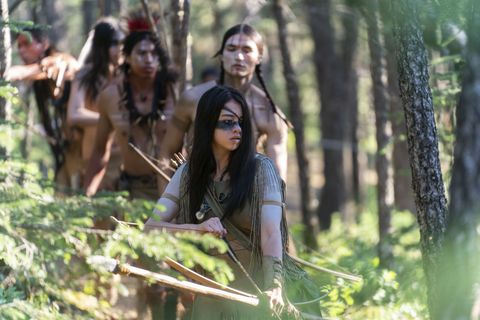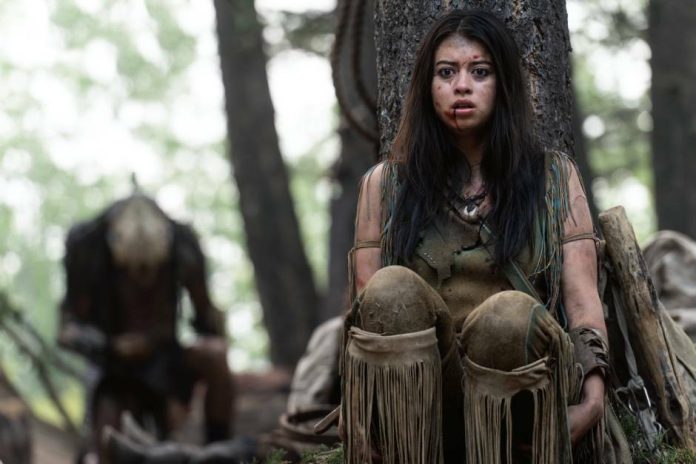What Tribe Do Naru and Taabe Belong to in Hulu’s “Prey” (2022) movie? – Based on the Predator franchise created by Jim and John Thomas, Prey is a 2022 American historical science fiction action film directed by Dan Trachtenberg and written by Patrick Aison. The fifth film in the series serves as a prequel to the preceding four movies. Julian Black Antelope, Michelle Thrush, Stormee Kipp, Dakota Beavers, Dane DiLiegro, and Amber Midthunder all appear in it.
At the start of the film’s development, John Davis was approached by Trachtenberg and Aison with a proposal they had been working on since 2016. The title of the movie was revealed to be a codename for the franchise’s fifth entry. Prey had its world premiere on July 21, 2022, at San Diego Comic-Con, and on August 5, 2022, it was made available by 20th Century Studios as a Hulu original movie. Critics gave the movie favourable reviews, praising the action scenes, Midthunder’s performance, the special effects, and the portrayal of the Comanche.
If you’re curious about which tribe Naru and Taabe belong to in the 2022 film “Prey,” stay reading to find out.

What Tribe Are Taabe and Naru Descended From?
The Comanche tribe is where Naru and Taabe are from. A Native American tribe from the Southern Plains of the modern United States is known as the Comanche. The federally recognized Comanche Nation, with its main office in Lawton, Oklahoma, is home to the current Comanche population.
The Uto-Aztecan family of Numic languages includes the Comanche language. At first, it was a Shoshoni dialect, but it grew apart and emerged as a distinct tongue. Historically, the Shoshone people of the Great Basin included the Comanche.
Comanche people inhabited in the majority of what is now northwest Texas in the 18th and 19th centuries, as well as nearby regions in eastern New Mexico, southeastern Colorado, southwestern Kansas, western Oklahoma, and northern Chihuahua. Comanchera is the name given to the historical region by Spanish colonists and afterward by Mexicans.
The Comanche lived a nomadic horse lifestyle during the 18th and 19th centuries and hunted, mainly, bison. They engaged in trade with American, Spanish, and French colonists and nearby Native American tribes.
The Comanche attacked and assaulted neighboring Native American tribes’ settlements as European Americans encroached on their area. They captured members of neighboring tribes during battle and either adopted them into their tribe, sold them as slaves, or gave them to the Spanish and (later) Mexican immigrants. Numerous captives from raids on American, Mexican, and Spanish settlers became part of the Comanche culture.
By the 1860s and 1870s, most Comanche was compelled to live on reservations in Indian Territory due to European diseases, conflict, and encroachment.
The Comanche Nation currently numbers 17,000 people, 7,000 of whom live in the southwestern Oklahoma communities of Lawton, Fort Sill, and the adjacent territories under tribal jurisdiction. In Walters, Oklahoma, the Comanche Homecoming Annual Dance takes place in the middle of July.
Myers told Bloody Disgusting, “It was amazing because, as a producer, I don’t typically get to produce stuff in my own culture.” “I’m Black Feet and a registered member of the Comanche Nation. They are both tribes of the Plains. I was thrilled to learn about this project because it related to my culture. Along with 19,000 other Comanches, I was born on Comanche territory. People think it’s incredibly difficult for me to work on this. But it wasn’t difficult for me because I could bring that authenticity.
I could give back to my neighbourhood. We required some older terminology because this is set 300 years in the past. Therefore, I would even call my grandpas. They are my traditional grandpas, not my biological grandpas. I’d give them a call. I’m outside mending my mailbox, one person said. I asked. How do you say this? What was this known as to your grandpa?
“We had such an influx of individuals, both in front of and behind the camera, from beginning to end,” Myers continued. Many First Nations individuals had the chance to work on a movie set in all the different departments as part of our intern program to see what they preferred. Therefore, working on this was a pleasure for me.














